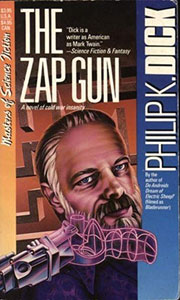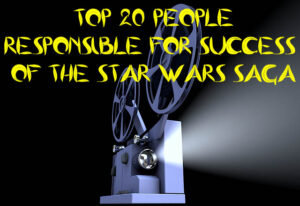Even by Philip K. Dick standards, “The Zap Gun” (1967) is particularly prophetic of the 21st century, but it’s also one of the harder novels to get into. It helps to know that, at its core, it’s a satire of the Cold War and the military-industrial complexes of the USA and the USSR. Dick unleashes so many new terms that a dictionary appendix would be helpful: “tearwep” for terror weapon, “pursap” for common citizen, “concomody” for product tester, to name a few.
Convoluted satire of something convoluted
“The Zap Gun” isn’t merely a satire, but a convoluted satire, which makes sense because it’s satirizing something that’s convoluted for the sake of obfuscation. The idea behind the Cold War between Wes-bloc and Peep-east (the extrapolation of the USA and USSR from the 1960s to the future of 2004) is to make money for interested parties by keeping the war going.
So main character Lars Powderdry’s job is to psychically enter another realm and come back with sketches of weapons, which are then developed, produced and tested in an underground complex that stretches from San Francisco to Los Angeles. Lars has a Peep-east counterpart, the mysterious Lilo Topchev, who does the same thing. Being a PKD character, Lars is immediately in love with Lilo.

Although the weapons work enough of the time that videos can be shown to the pursaps (the weapons are tested on androids and non-sentient animals), the idea is for both world powers to have an ever-escalating but similar amount and quality of weapons. Neither side wants a hot war, but they want the money to keep flowing from taxpayers into the desired coffers. Toward that end, both governments employ KACH, a spy agency that keeps each side informed on what the other is doing.
So when aliens start positioning satellites around Earth, Wes-bloc and Peep-east immediately start working together “Independence Day” style. But the problem is that it’s extremely unlikely that Lars and Lilo, even working together, and even with their romantic bond, will dream up an effective weapon. (Lilo fairly quickly warms to Lars, in classic PKD female lead fashion, although she does try to kill him too.) When the first satellite appears, it’s like a punchline to a joke, such is the darkly humorous nature of “The Zap Gun.”
PKD reflects on how and why the Cold War continues, giving us perspectives of, and reflections from, many individuals. How is it, the author asks, that people are both comforted by the introduction of new weapons yet also mistrustful of their government? Indeed, it’s a strange paradox, and as one examines it closer, one gets further away from a logical answer.
Febbs as the common man
Representing the common man — sort of — is Surley G. Febbs. Perhaps responding to growing concerns that elected officials don’t truly represent the electorate, Wes-bloc’s defense department (the most powerful governmental body; Congress is basically an afterthought) has six slots reserved for randomly selected citizens.
Febbs is drawn for one of those slots and instructed to come to the underground kremlin (the Russian word for citadel) in Festung (the German word for fortress) Washington, D.C. (This isn’t a “Man in the High Castle” situation where Germans rule the USA. But Dick does foresee an increasing worldwide melting pot, apparently.)
However, dodging the six citizens is easy; the military simply invokes a state of emergency wherein the citizens are barred from the meetings. The desire to exercise his Constitutional right to be on the board inspires Febbs. And ultimately, even though he’s drawn from a hat rather than elected, Febbs wants power too. There’s no “appropriate” level of power at which someone in power tends to be content, PKD says.
Dick borrows from two of his short stories to give “The Zap Gun,” in which the plot is in the background, an ending: “War Veteran” (1955) and “War Game” (1959). But only the jumping-off points are the same, so novel readers will not know where things are going. “War Veteran” is about an old man who sits on a bench mumbling stories; it turns out he has traveled back in time from a future war and his knowledge could save humanity, if only someone will listen to him. “War Game” is about how children’s games can encourage specific values.
The latter is particularly germane to “The Zap Gun’s” conclusion, and also a satire (purposeful or not, I’m not sure) of how people in the 21st century are distracted by video games and other trivialities like social media at the expense of important issues – in the book’s case, a gosh-darn alien invasion.
Comic book within a book
Also in the mix is a comic book, “The Blue Cephalopod Man from Titan,” that draws its ideas from the same dimension where Lars and Lilo get their weapons. Here, in addition to pointing out the similarities between crazy fiction and sober fact, PKD is perhaps making fun of pulpier sci-fi works, including his own.
“The Zap Gun” is such an idea-based novel that I find myself giving short shrift to Lars and Surley, but they are both entertaining to read about. Lars is unfulfilled by his job, knowing that his job security is dependent on him being less than totally successful at inventing weapons. And Surley is the smartest guy in the room, but only in his own mind. Clinching his insanity, he names his revolutionary group BOCFDUTCRBASEBFIN, which is an acronym for something.
Between the new words and the acronyms, “The Zap Gun” can get clunky, and it flirts with being such a wild mishmash of ideas that it’s not grounded. But ultimately, the warnings of “The Zap Gun” tie so closely with modern reality that all the laughs and absurdities are tempered, and the book is almost as readable as it is prophetic.


